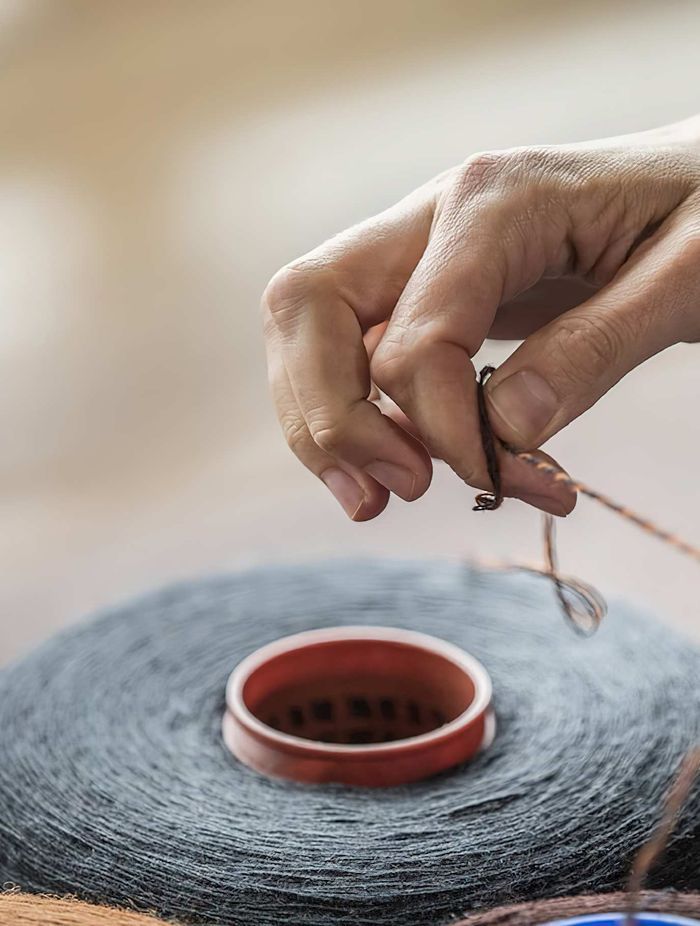The future looks wooly

When we went searching for a partner to deliver the finest wool fabrics available, we didn’t have to travel far. Gudbrandsdalens Uldvarefabrik AS was established in 1887, in Lillehammer, Norway. They are an award-winning and innovative textile manufacturer that specializes in wool. Together, we have created a line of modern wool upholsteries that have a unique combination of sustainability, durability, comfort, and style.
Timeless and smooth
The collaboration with the Stressless® brand is very exciting in several ways. One advantage for the consumer is that they can follow the value chain all the way. The company behind the brand, Ekornes, is a market-leading manufacturer with a high degree of innovation, with an exceptional quality and standard of its products. GU is a Norwegian manufacturer with a long history that has a high level of expertise in woolen textiles and is known for delivering quality products with a long lifespan. So when Ekornes wanted to use textiles based on wool, this was a perfect match, says Karen Lauvålien, Sales and Marketing Director at Gudbrandsdalens Uldvarefabrik AS.
One of the results is Clover, a timeless, mélange fabric in a modern and subdued palette. The smooth and soft surface is underlined by restrained colours. Clover is a fabric with a warm and welcoming character, perfect for attractive interiors that evoke a homely and safe feeling. A perfect match for other natural materials such as leather, metal and stone. The fabrics are designed by Merete Haabeth Serrano and the colours are designed by Ragnhild Nordhagen and Christiane Müller.


Durable and sustainable
Why is wool such an important part of the Norwegian heritage?
The sheep is one of Norway’s oldest domestic animals, and our wool processing traditions go back many generations. Today, Gudbrandsdalens Uldvarefabrik uses wool from approximately 120.000 sheep annually. It is also a locally sourced raw material. The wool used in our production is carefully selected from areas near the coast, as this is where we find the sheep with the cleanest fleeces. It must contain as little vegetable matter as possible, like seeds, twigs and burrs, says Lauvålien. More than 50% of the wool used in the production comes from Norwegian sheep.


How exactly is it a sustainable material?
Wool is biodegradable and a renewable resource. It has amazing natural properties; we call it natures “high tec”. Wool does not burn, and it doesn´t have to be treated with chemicals to meet the requirements for flame retardancy on the furniture. In addition, it does not need washing as frequently as other fibre types, and it has a long lifespan, says Karen Lauvålien.
Why is it peaking in popularity right now?
We have seen a trend emerge during the corona pandemic: We want to shop safely, and there is a great demand for Norwegian quality goods. Wool is also closely connected to nature. It’s genuine, honest, and represents comfort and reassurance.


Facts:
1. Wool attracts moisture
It can absorb up to 30% moisture in relation to its own weight without feeling wet or damp. This means that a piece of furniture or a garment in wool will prevent a clammy feeling.
2. Wool is self-cleaning and has antibacterial properties
Wool garments should be aired after use and do not need to be washed as often. Wool also prevents bad smells.
3. Wool is heat-regulating
It cools in summer and warms in winter. An upholstery fabric in wool feels dry and comfortable to sit on.
4. Wool is 100% natural
Wool is a protein fiber on a par with human hair and grows naturally on sheep.
5. Wool is easy to clean and maintain
It is naturally water-repellent. This means that it is very resistant to impurities. Addition of impregnating agents to wool is unnecessary during normal use.
6. Wool is elastic and holds well in shape
When the wool is stretched out during use, it returns to its original shape afterwards. Wool provides robust, durable fabrics that help garments and furniture withstand hard use over a long period of time without appearing worn.
7. Wool attracts little dust
Wool is a wet fiber and is naturally anti-static. This means that it does not attract dust like other, dry fiber types.
8. Wool is well suited as a starting point in noise-reducing fabrics
This is due to the three-dimensional shape of the wool fiber. It has a spiral-shaped structure that holds in air and thus provides both heat-insulating and noise-reducing properties.
9. Wool is a natural flame retardant
When exposed to fire, wool gets charred, but does not burn or melt. This means that we produce flame retardant fabrics for normal use without the use of chemicals.

